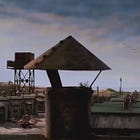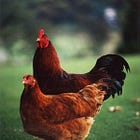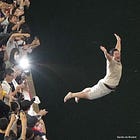This is the next installment in a dramatic tale of how chicken secured its reign as supreme meal in Japan. Last time, we learnt how the American occupation of Japan brought with them the entire chicken infrastructure and paved the path for KFC to launch. Yet we find ourselves with a Japan maybe not yet ready for the high calorie, low nutrition world of American fast food.
The first fast food
As I’ve discussed previously, Japan likes food and loves adopting foreign foods as their own. Perhaps the most accessible form of foreign food has been fast food chains, but fast food was still a new concept in 1970s Asia. Home cooked meals were still predominant, while izakayas and restaurants had been the traditional form of dining out. Times were changing with newer street stalls being common for quick bites, where food was prepared in front of customers eyes. These were all still quite intimate settings between man and food, an almost manual period of dining.
Welcome to another thin excuse to discuss American fried chicken chains, and to learn where KFC went right in Japan.
We left off last time with KFC recognising that their fried chicken was enough to win over American tourists but needed some changes for the actual Japanese customers. Having wrapped up a moderately successful stint at the American Park at the Osaka World Expo, the company was now deciding where to situate their new store. The obvious choice would be in the heart of the action, an area known for high foot traffic and a need for near instant food. Luckily, Japan had a globally famous location that completely met this description… suburban Nagoya?
Instead of choosing the bright lights of Shibuya Tokyo, or really any city centre, the American executives overruled local Mitsubishi intel to set up their first foray in a residential neighbourhood.
The grand entry was a disaster.
Instantly issues emerged that weren’t exposed during the test run. First off, 1970 suburbia Japan did not have a strong grasp on the English language. This was a problem when all the signs for KFC were in English. People were basing their understanding of the store from the iconic red and white stripes, so would ask “is this a barber?”.
The dream of KFC Japan was crumbling before their very eyes. Mitsubishi, the ostensible domestic partner, had rightly surmised that the Americans weren’t open to listening to their advice, so were looking to get themselves out of this 15-year deal. But if chain restaurants have one defining feature, it is the chains. By the middle of 1971, they were opening their fifth store.
As they added more stores, they finally started to realise that they should target younger, higher-density and walk-heavy destinations. While this helped stabilise sales, The Japanese KFC team was still scrambling, without any indication that Mitsubishi, or for that matter KFC USA, were going to support this floundering fast food chain. Even worse, their arch nemesis was looking to enter the market; Ronald McDonald would arrive in Japan in 1971. The Kentuckians needed an idea to endear them to Japan, and it needed to come quick.
What’s Red and White All Over?
We are at the great myth-making section of the KFC Japan epic. The franchise was at a standstill with little loyalty to this foreign brand. But the executives knew that they had one mission in this world and that was to sell buckets of chicken.
In a moment that can only be defined as divine intervention, manager of the Nagoya branch and future KFC Japan president Shin Okawara would encounter a life-changing idea. He describes it thusly.
A local nun from the Catholic school wanted to order a bucket for her class as a treat for Christmas. Being a nun and being Christmas, she asked for one more favour. She wanted Santa to deliver the bucket. Okawara’s store wasn’t exactly filled with customers, so he went himself as the man in red.
On the way, he started singing his own Kentucky Christmas song ‘Kentucky Christmas! Kentucky Christmas! Happy happy!’. By the time he got back to his branch, the basis of KFC’s most enduring tradition was born. Christmas dinner was a bucket of fried chicken. It was a match made in marketing heaven.
Okawara wasted little time promoting his new idea. There he was, on every station, telling the airwaves that actually all Americans ate chicken for Christmas. Forget turkeys—if you want to celebrate Christmas properly it’s all about the chicken. Given Christmas was still a new concept, but fit the idea of Japanese culture, any tradition was better than nothing. Naysayers will nay and and say the only reason KFC got associated with Christmas is that when you add a Santa hat to Colonel Sanders, he looks suspiciously similar.
Whatever the true origins for the cultural assimilation of Christmas in Japan, KFC saw an almost immediate benefit. By 1974, the Okawara-coined Kentucky Christmas jingle had become a mass televised ad. The marketing campaign was genius: it stripped away any pesky ideas that Christmas was a cultural, spiritual or religious time in the West. Instead the message is Christmas = Chicken. In a sign of how well the turnaround had been, even the late Colonel would visit Japan; Harlan Sanders on his third and final visit commented that the fried chicken served here was better than in Kentucky.
A decade on from their shaky launch, KFC Japan had become a business success story. A 1981 corporate training video shows how the company was already being lauded as the example to all other firms on how to conduct business in Japan, with helpful advice like “Japan is different to the USA” and “train and listen to your employees”.
Admittedly, KFC’s local team was able to bridge the cultural gap by using Japanese cultural norms and not deciding that they alone had superior ideas. This insight changed their approach to focus on long-term employee training as the Japanese KFC employees were likely staying for a career rather than a job over summer. Similarly they adjusted their formula on picking locations, this time with foot traffic and population as important factors. They ditched their ideas of freestanding US-style stores and accepted that Japan did things differently.
KFC had overcome some of their most entrenched problems, not only through Christmas magic but through the power of listening. Yet even listening can’t rescue you from a curse. We are not yet done with KFC and its hypnotic spell over Japan. Learn how this once foreign entity has now become a key part in Japanese pop culture, spawning yearly rituals, video games and even a battle for supremacy with Japanese sports?
Catch the finale here:








You! You and your chickens!! ;)
Turning a relatively mundane story into a gripping yarn is one of the signs of a good writer. The edge of my seat is going to need re-upholstering :)
Thank you!